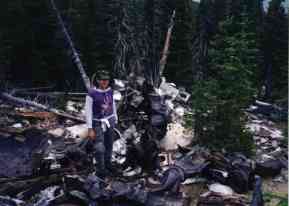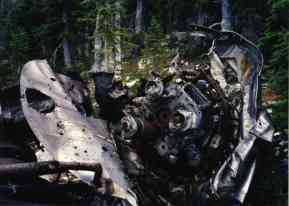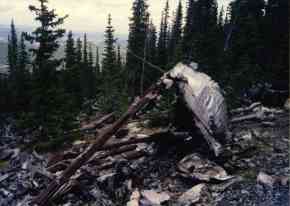


first hike together.
Trips to the Crown Point B-17
The Crown Point B-17 was my first seached-for wreck. . This was one that had survivors, had been in the newspaper and was Duke’s project. Strangely, no one had coordinates for it but there were generalized areas published in the newspapers. (They said which mountain it was on.)
I was able to wheedle a description of the location from a National Forest Service employee who seemed to be concerned that after 50 years, looting would begin the moment it became public even though it had been in the newspapers several times in the past months. I went to the NFS because it seemed sensible that they would know what was on their land and would be helpful. (Neither of these was exactly true.)
I finally was given enough terrain description over the phone that I could pretty much place it on the map because it was within a few hundred yards of a small saddle on the Flowers Trail on the side of a hill where the saddle would be unique and unmistakable.
On August 28, 1994 I set out to hike to this wreck via the Brown’s Lake trail. BLT traverses high tundra with fine views and, I thought, would tend to hold elevation better than the alternate route which would have been to come in from the other end of Flowers Trail and climb the side of the hill. I have come in by the "low road" which is surely the worst approach. All of the high tundra alternatives begin on the Crown Point Road at various points. Most convenient parking places seem to be where the road crosses one or the other branch of Sheep Creek.
My first visit to the site was a solo effort where I left town early, got to the trailhead early and set off in fairly familiar territory. I had hiked to Brown’s Lake in the past and had solo camped in the area as well. It’s a fine area of sparse trees, tundra, rounded ridge tops and views of forever.
It took me 3 hrs to reach the saddle where I was reasonably certain the wreck was nearby. Snow survey markers seemed suspicious and after perhaps 20 minutes of slowly easing thru the trees on the hillside I found small bits of aluminum scattered in the trees and, eventually, the wreck.
It was impossible to understand how anyone could have survived the wreck. But all 4 engines were present, the landing gear struts were there, the top turret gunner’s turret frame was there and so forth. The wreck seemed complete though very, very shredded. I was to learn later that the Army dynamited the wreck which explained its terrible condition. Still, there were 4 big radial engines, 2 large landing gear struts, a steel main spar, lots of wiring bits, scraps and fragments of aluminum and more things to examine than a guy had time to do.
(Click on the picture to get an enlarged image)
 |
 |
 |
| Thomas Gallegos poses with an engine on our
first hike together. |
One of the engines. | Steel truss & view to the NE |
The view from the wreck site is rather interesting in that even now, in AD 2000, over 50 years after the crash, the view on a clear sunny day reveals no signs of civilization toward which a stranded crewmember could walk. There are fine views of the Laramie plains to the north, and some of the plains to the northeast but there is no jeep trail nor house within sight. If one were to stand here on an early June day waist-deep in snowdrifts, one would be seeing what the survivors saw. Remarkable.
There are two other stories from recent history regarding this wreck.
Reportedly, a young man and his buddy hiking in this same area in the 1960’s found a .50cal machine gun in the woods. They thought this was exceedingly interesting and determined to try to take this chunk of steel home with them. The two boys lugged that gun for quite a ways before figuring out that it was too heavy to take much further. They then ‘hid’ the gun by burying it under a pile of rocks "like an old-west grave" and then went back to camp. They never returned for the gun. One young man became the mayor of Greeley, CO.
In about 1980, another young man was out hunting in the area and reportedly found a machine gun lying behind a log. He brought the gun home as a curiosity. His father, being a law-abiding gun owner, turned pale at the sight of an unregistered machine gun entering his home. He knew that the Bureau of Alcohol, Tobacco, and Firearms (BATF) believe that "once a machine gun- always a machine gun" would apply to this rust-ravaged, bent-barrelled piece of history and that possession of this device constituted a Federal Felony. The father called the Loveland Police Department to come get it. It now resides in the City of Loveland Museum.
Last Modified: 1/1/2008